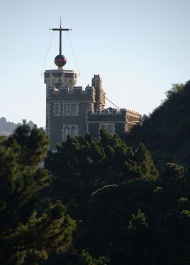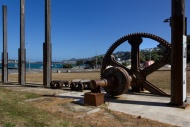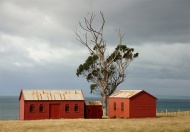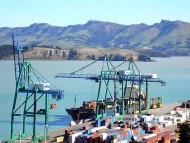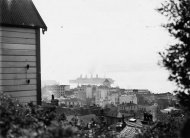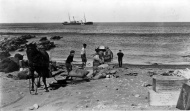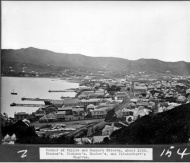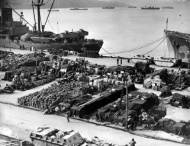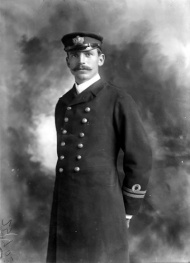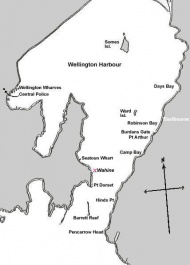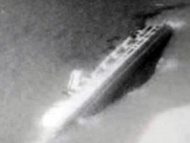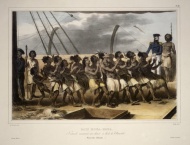Events In History
-
 15 September 1976Lyttelton–Wellington ferry service ends
15 September 1976Lyttelton–Wellington ferry service endsThe last sailing of the Rangatira brought to an end more than 80 years of regular passenger ferry services between Lyttelton and Wellington. Read more...
-
 11 August 1962Picton ferry Aramoana enters service
11 August 1962Picton ferry Aramoana enters serviceThe country's first roll-on roll-off ferry, New Zealand Railways' Aramoana revolutionised transport between the North and South islands. Read more...
-
 15 August 1951Troop ship Wahine wrecked en route to Korean War
15 August 1951Troop ship Wahine wrecked en route to Korean WarCarrying New Zealand troops to the Korean War, the 38-year-old Lyttelton–Wellington ferry Wahine ran aground in the Arafura Sea. There were no casualties but the ship became a total loss. Read more...
-
 17 August 1942Attack on the Nino Bixio
17 August 1942Attack on the Nino Bixio118 New Zealand prisoners of war died when the Italian transport ship Nino Bixio was torpedoed by a British submarine in the Mediterranean. Read more...
-
 27 November 1940Liner sunk by German raiders off East Cape
27 November 1940Liner sunk by German raiders off East CapeThe 16,712-ton New Zealand Shipping Company liner Rangitane was intercepted and sunk 550 km off East Cape, with the loss of 15 lives. Read more...
-
 20 August 1940Turakina sunk by German raider in Tasman
20 August 1940Turakina sunk by German raider in TasmanIt was the first naval battle in the Tasman Sea. The New Zealand Shipping Company freighter Turakina was intercepted and sunk by the Orion nearly 500 km off the Taranaki coast with the loss of 36 lives. Twenty survivors were taken prisoner. Read more...
-
 23 October 1915Ten NZ nurses lost in Marquette sinking
23 October 1915Ten NZ nurses lost in Marquette sinkingThirty-two New Zealanders, including 10 nurses, were killed when the troop transport Marquette was torpedoed by a German U-boat. Read more...
-
 16 April 1912News of Titanic sinking reaches NZ
16 April 1912News of Titanic sinking reaches NZAlthough no New Zealanders were aboard the world’s largest passenger ship when it sank in the chilly North Atlantic with appalling loss of life due to a lack of lifeboats, the country followed the news closely. Read more...
-
 29 April 1881131 perish in worst civilian shipwreck in NZ waters
29 April 1881131 perish in worst civilian shipwreck in NZ watersThe steamer Tararua, en route from Port Chalmers to Melbourne, struck a reef at Waipapa Point, Southland. Of the 151 passengers and crew on board, 131 were lost, including 12 women and 14 children. Read more...
-
 2 May 1868First shipment of salmon and trout ova arrives
2 May 1868First shipment of salmon and trout ova arrivesThe clipper Celestial Queen arrived at Port Chalmers carrying the first shipment of live fish ova from England. These fish were intended to provide sport for the settlers, but none survived. Read more...
-
 3 February 1868Killer storm sweeps the country
3 February 1868Killer storm sweeps the countryA cyclone swept south across the country from Saturday 1st. By the time it moved away on Tuesday 4th, more than 40 people had been killed. Read more...
-
 20 May 1865Loss of the City of Dunedin with all hands
20 May 1865Loss of the City of Dunedin with all handsThe paddle steamer City of Dunedin left Wellington at around 5 p.m. on Saturday 20 May. It was never heard from again and no trace was ever found of its 25 crew and at least 22 passengers. Read more...
Articles
New Zealand disasters timeline

The disasters timeline and map give an overview of New Zealand's worst natural disasters, transport accidents, fires, mining accidents and other tragedies that have caused major loss of life.
- Page 1 - New Zealand disasters timelineThe disasters timeline and map give an overview of New Zealand's worst natural disasters, transport accidents, fires, mining accidents and other tragedies that have caused major
Wahine disaster

This April marks the 45th anniversary of the sinking of the ferry Wahine. With more than 50 lives lost, this was New Zealand's worst modern maritime disaster. The Wahine’s demise on 10 April 1968 also heralded a new era in local TV news as pictures of the disaster were beamed into Kiwi living rooms.
-
Page 2 – Timeline to tragedy
The events that led to the drowning of 51 people in the Wahine disaster of 10 April 1968
-
Page 3 – Co-ordinating the rescue
The police, emergency services and civilians rescued passengers and crew from the inter-island ferry Wahine in Wellington Harbour in April 1968.
Oamaru Harbour

Ports were the beachheads of colonial expansion. No town could prosper without one. Oamaru Harbour, which closed to shipping in 1974, is the best place in the country to see how and why all New Zealanders once depended so heavily on sea transport.
-
Page 2 – Early days
European settlement at Oamaru began in 1853, and in the 1860s the town grew rich servicing pastoralists and gold miners. Oamaru, though, was no port. Cape Wanbrow, a stubby
-
Page 3 – Colonial beachhead
The disastrous storm of 1868 forced Oamaru to invest in the construction of expensive concrete breakwaters and new larger wharves.
-
Page 4 – Deep-water port
Oamaru's shipping tonnages rose after the First World War, but the port faced tough times as coastal shipping slumped from the 1960s.
-
Page 5 – Oamaru Harbour after 1974
Although Oamaru no longer has an active port, tourism has brought new opportunities to the town and its harbour.
Pencarrow Lighthouse

On 1 January 2014 Pencarrow Lighthouse at the entrance to Wellington Harbour celebrates its 155th anniversary. New Zealand’s first permanent lighthouse, Pencarrow was also home to this country’s first – and only – female lighthouse keeper.
-
Page 2 – Slow beginnings
It took 20 years for the first settlers to get a decent lighthouse built at the entrance to Wellington Harbour.
-
Page 3 – The lighthouse and its surroundings
Key events in the development of the Pencarrow Lighthouse
-
Page 4 – Pencarrow Lighthouse keepers
The experiences of the Pencarrow Lighthouse keepers and their families
-
Page 7 – Further information
This web feature was written by Imelda Bargas and produced by the NZHistory.net.nz team.Links 'Guardians of the Light' - documentary about lighthouse keepers (NZ On Screen
Merchant marine

On 3 September New Zealand honours Merchant Navy Day. Here we explore the little-known but vital role played by the merchant marine during the First World War, when these civilian seafarers often found themselves in the front line of the war at sea.
-
Page 2 – The merchant marine goes to war
The outbreak of war in 1914 posed special problems for New Zealand because of its dependence on sea trade.
-
Page 7 – Home waters
The First World War had a dramatic impact on shipping to and from New Zealand.
Container shipping

Forty-five years ago, on 19 June 1971, the first all-container ship to visit New Zealand arrived in Wellington. Columbus New Zealand was part of a worldwide revolution in shipping. These simple steel boxes would change our transport industry, our ports and how we work and shop.
-
Page 2 – The container is born
A US trucker’s ‘out of the box’ solution led to the container shipping system we know today
-
Page 3 – Transforming shipping
By the late 1960s, the valuable Atlantic trade was being containerised. New Zealand ports followed developments closely, since some ports were expected to lose much of their
-
Page 4 – Transforming our ports
Containerisation changed the very look of our ports. In the 1970s the four cellular container ports – Auckland, Wellington, Lyttelton and Port Chalmers – reclaimed land, filled
-
Page 5 – Transforming our economy
Containers changed everything. Railways ordered fleets of flat-deck rolling stock and ‘daylighted’ tiny Victorian tunnels so they could get through. Truckers bought heavy-duty
-
Page 7 – The wreck of the Rena

On 5 October 2011 the MSC-chartered, Liberian-flagged container ship Rena astonished local mariners by grounding on the clearly marked Astrolabe Reef off Tauranga. Three months
Royal NZ Navy's Bird-class ships

October 2011 marks the 70th anniversary of the formation of the Royal New Zealand Navy. In 1941 the new navy had three brand-new ships – the Moa, Kiwi and Tui – working up or fitting out in Scotland. These little Bird-class minesweepers would see dramatic action in the Pacific War.
-
Page 2 – 'Pocket corvettes'
The Birds were unusual. Although they looked a little like the Admiralty’s Isles-class minesweeping trawlers, their extended forecastles gave them more of a naval look
-
Page 3 – Early wartime duties
When the ships finally arrived at Auckland between April and August 1942, after lengthy voyages, they joined the 25th Minesweeping Flotilla
-
Page 4 – Moa and Kiwi bag a sub
On the night of 29 January Kiwi and Moa were patrolling along Kamimbo Bay, on the north-western corner of Guadacanal when Kiwi detected a submarine
-
Page 5 – The sinking of the Moa
On 7 April 1943, while refuelling from the American oil barge Erskine M. Phelps at Tulagi Harbour, in the Solomons, the Moa came under attack from Japanese aircraft
-
Page 6 – The Tui goes hunting
The minesweeper Tui’s turn to claim a scalp came in August 1943
-
Page 7 – Peacetime years
The RNZN downsized after the war, although it remained much bigger than the pre-war New Zealand Division.
-
Page 8 – Further information
Links and books relating to New Zealand Bird-classs minesweepers
HMNZS Leander

When the Royal New Zealand Navy came into being on 1 October 1941, its main combat units were two Leander-class cruisers: Achilles and Leander. Although its early war was quieter than the Achilles, the Leander was to see dramtic action in the Pacific War.
-
Page 2 – Leander-class light cruisers
Facts and stats about the Leander light cruiser ships
-
Page 3 – Leander goes to war
By mid-1940 the Leander was escorting convoys in the Red Sea and Aden areas. In between escorting merchant ships, the cruiser further pummelled the Italian submarine Torricelli
-
Page 4 – Pacific attack
After some early successes, the Leander's war came to an end when she was hit by a long-range Japanese torpedo
-
Page 5 – Recovery and repair
The Leander was hit just abaft the ‘A’ boiler room. Four hundred and ninety kilograms of high explosive killed everyone in that boiler room and the blast, venting
-
Page 6 – Last days
The Leander never fought under the New Zealand ensign again and was eventually scrapped in 1949
-
Page 7 – Further information
Links and books relating the to the HMNZS Leander
D-Day

It was one of the largest amphibious landings in history. On 6 June 1944 a huge Allied military machine embarked on the invasion of German-occupied France. Thousands of New Zealand sailors and airmen were on active duty that day.
- Page 2 - The grand plan The plans for the Allied invasion of France were conducted in great secrecy and over several months.
The Merchant Navy

3 September is Merchant Navy Day, which was first officially commemorated in New Zealand in 2010. The date marks the sinking of the first Allied merchant ship in 1939, just hours after the Second World War began. This is the story of the 'fourth service' at war.
-
Page 4 – The Battle of the Atlantic
Although it was waged half a world away, few military campaigns were as vital to New Zealand's interests as the Battle of the Atlantic. A German victory, which would have
Lyttelton-Wellington ferries

For more than 80 years the overnight Lyttelton ferry was a vital link in the country's transport network.
-
Page 3 – The early years
Although many ships sailed between Lyttelton and Wellington during the course of their longer voyages, a regular passenger service between those ports took time to develop.
-
Page 4 – Politicians and ferries
Politicians used the ferries to travel between their electorates and Wellington, so they scrutinised the Union Steam Ship Company's management of the ships.
-
Page 5 – Cabins de luxe and glory holes
The purpose-built Maori of 1907 was a big leap forward, but description of the cabins was limited to ‘well endowed with spring mattresses and superior bed coverings'
-
Page 6 – Just like clockwork
Every night, weather and sea conditions permitting, two ships crossed in the night at about 1.25 a.m. off the Kaikoura coast as perhaps 1500 New Zealanders passed quite
-
Page 7 – Officers and gentlemen?
Some of the ferry masters – each known as ‘the Old Man' to the crew – were almost as well known as the ships themselves.
-
Page 8 – In strife and war
The Lyttelton–Wellington ferries were such a vital link for travellers that they were given priority whenever strikes or lockouts paralysed the wharves, but wars
-
Page 9 – End of the line
In the face of competition from other forms of transport the Union Steam Ship Company abandoned its glamour ferry service, sending the Maori to the scrappers in 1974.
-
Page 10 – Ferry tales
Some people tell their stories of travelling on the Lyttelton–Wellington ferries.
Assisted immigration, 1947-75

New Zealand is a country of immigrants. Wave after wave of peoples have settled here: Polynesian, British, European, Asian.
- Page 4 - The voyage outThe Captain Cook, along with the Captain Hobson, brought assisted immigrants to New Zealand via the Panama Canal from
The Vogel era

In 1870, Colonial Treasurer Julius Vogel launched the most ambitious development programme in New Zealand’s history. The ‘Vogel era’ was a decisive moment in New Zealand’s 19th-century transformation from a Māori world to a Pākehā one.
- Page 2 - New Zealand in 1870Three decades after the signing of the Treaty of Waitangi, New Zealand’s two main islands were like two different
Hospital ships

The Maheno and Marama were the poster ships of New Zealand's First World War effort. Until 1915 these steamers had carried passengers on the Tasman route. But as casualties mounted at Gallipoli, the government - helped by a massive public fundraising campaign - converted them into state-of-the-art floating hospitals.
- Page 2 - BackgroundWhat is a hospital ship and where did New Zealand's two ships come
A frontier of chaos?

In the years before the signing of the Treaty of Waitangi, relations between Māori and Europeans were marred by a number of high-profile incidents.
- Page 4 - The Boyd incidentIn December 1809 the sailing ship Boyd was anchored in WhangaroaHarbour. It was attacked by a group of Māori who killed most of its crew and passengers in retaliation for the
Nuclear-free New Zealand

The sinking of the Greenpeace protest ship Rainbow Warrior in Auckland in July 1985 shocked the nation. The incident galvanised an anti-nuclear movement that had emerged in opposition to both French nuclear tests at Mururoa and American warship visits to New Zealand.
- Page 5 - Sinking the Rainbow WarriorIn 1985 New Zealand was basking in its position as leader of the anti-nuclear movement. Then on 10 July, two explosions set by French Secret Service agents ripped through the hull
Pacific aftermath

Participation in the First World War changed Pacific Islanders' lives. Returning servicemen had seen the world.
- Page 3 - Troop repatriationWhen the Armistice was signed in November 1918, Pacific island troops in New Zealand service were stationed in a number of
The 1913 Great Strike

The Great Strike of 1913 was in fact a series of strikes between mid-October 1913 and mid-January 1914. It was one of New Zealand’s most violent and disruptive industrial confrontations.
- Page 3 - Outbreak of the 1913 strikeThe 1913 Great Strike was sparked off by two relatively small
Notes for My Successor

Until the late 1960s New Zealand's Governors-General were British, mainly minor aristocrats or admirals or generals.
- Page 7 - The Governor-General on the moveHow the Governors-General moved about the
Flags of New Zealand

The New Zealand flag hasn't always been our official flag. It was adopted in 1902, replacing the Union Jack. Between 1834 and 1840, the flag of the United Tribes was recognised as our first 'national' flag. Waitangi Day 2010 saw the first official recognition of the national Māori flag.
-
Page 5 – Other official flags
Six flags other than the New Zealand flag are flown for official purposes in New Zealand.
The Salonika campaign

23 October is the anniversary of the 1915 sinking of the Marquette with the loss of 32 New Zealanders, including 10 nurses. They were en route from Egypt to the Greek port of Salonika as New Zealand’s contribution to the little-known Allied campaign in the Balkans
- Page 5 - NZEF involvementThe New Zealand Expeditionary Force (NZEF) provided no combat units for the campaign in Salonika. The official contribution of New Zealanders was brief but marked by tragedy.
Related keywords
- wellington city
- pioneer battalion
- WW1 home front
- 1913 strike
- dunedin
- nelson city
- protest
- devonport
- lyttelton
- hms philomel
- auckland city
- WW1
- coromandel town
- hospital ships
- marama
- maheno (hospital ship)
- salonika campaign
- marquette disaster
- nurses
- disease
- trade unions
- huntly
- coal mining
- workers rights
- red feds
- german samoa occupation
- wellington harbour
- WW2
- navy
- royal new zealand navy
- gallipoli campaign
- lemnos
- container shipping
- hmnzs leander
- patea
- dairying
- historic places
- economy
- anzac cove
- transport
- pacific war
- ernest shackleton
- antarctica
- nimrod
- quail island
- horses
- huskies
- film
- timaru
- time
- CEISMIC
- canterbury earthquakes
- queen elizabeth
- britannia
- northland
- timber
- whangaroa
- picton
- assisted immigration
- rarotongan company
- fiji
- gilbert islands
- influenza pandemic
- niue
- pacific islanders
- italians
- casualties
- business
- anzac
- farming
- matanaka
- auckland harbour board
- lighthouses
- pencarrow head
- merchant marine
- international trade
- british empire
- tolaga bay
- painting
- oamaru
- roadside stories
- new zealand wars
- te kooti
- chatham islands
- puriri sinking
- whangarei
- disasters
- hokitika
- MPs
- ferries
- merchant navy
- shipwrecks
- floods
- japanese
- submarine
- governor-general
- trains
- cars
- railways
- julius vogel
- gold
- provinces
- oamaru harbour board
- korean war
- port chalmers
- north african campaign
- prisoners of war
- oamaru harbour
- ngaruawahia
- NZ Wars memorial
- waikato wars
- royal navy
- rena sinking
- wahine disaster
- tauranga
- astrolabe
- jules dumont d'urville
- cook strait
- governor
- health
- aquitania
- food
- william massey
- immigration
- immigrants
- british
- postcard
- memorials
- maketu
- advertising
- stewart island
- centennial
- royalty
- sidney holland
- seafarers
- bluff
- german navy
- flags
- royal new zealand air force
- american forces
- oral history
- 1950s
- cold war
- DDay
- richard seddon
- battle of the river plate
- HMS Achilles
- cape helles
- waterfront dispute
- south african war
- publishing
- boer war
- hms new zealand
- battle of jutland
- edmund hillary
- children
- poster
- lord liverpool
- newtown
- seatoun
- frank worsley
- WW2 stories
- english
- police
- writing
- hunterville
- conservation
- pre-1840 contact
- boyd incident
- rainbow warrior bombing
- 1980s
- greenpeace
- epidemic
- television
- broadcasting
- haka
- explorers
- nuclear free
- mururoa protest
- international relations
- music
- songs
- music month
- air transport
- erebus disaster
- tangiwai disaster
- timeline
- hawkes bay earthquake
-
Main image: Loading ship at Glasgow Wharf, 1918























